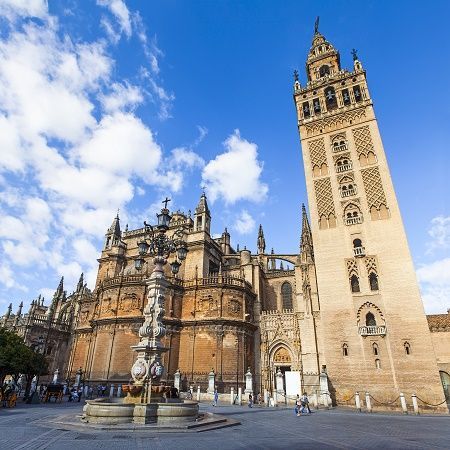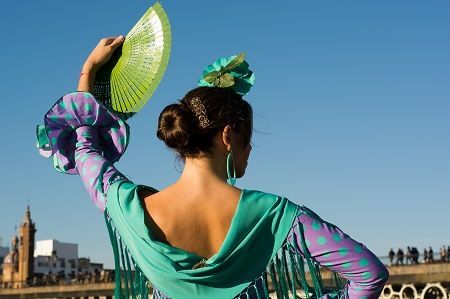Article
Cruise Ports: Cádiz Part 1 -- Gateway to Seville
Author(s):
Cádiz, Spain, 68 miles from Seville, serves as Seville’s port city. Even though there’s so much to see, it’s wise to be selective, choosing one or two attractions so that you have time to stroll.

Seville's skyline.
Cádiz, 68 miles (a 90-minute drive) from Seville, serves as Seville’s port city. The capital of Andalusia and a former Muslim stronghold, Seville offers a wealth of attractions—a centuries-old palace, a stunning cathedral, fragrant gardens, and interesting museums. Even though there’s so much to see, it’s wise to be selective, choosing one or two attractions so that you have time to stroll.
By walking Seville’s streets, you can note the purple bougainvillea cascading from the window boxes of white-washed houses, the weathered faces of the old men sitting in cafes, and the lush orange trees, 20,000 of which grace the city. After touring, let the aromas of spicy chorizo, sautéed clams, oysters au gratin, and other dishes pull you through a neighborhood. Select a tasca (inexpensive bar) for tapas and glasses of wine for lunch.
Top 3 Seville Attractions

Royal Alcázar (Reales Alcázares) and Gardens
A masterpiece of pillars and passageways, inner courtyards and sequestered rooms sparkling with tile work as well as lavish gardens, the Royal Alcázar, a UNESCO World Heritage site, began as a fortress constructed in 913 by Andalusia’s first caliph. Enlarged over the centuries, the structure bloomed as a grand palace in the 14th century under Pedro I, a Christian king. Although the palace continued to evolve over the centuries, illustrating many architectural styles, the Royal Alcázar shines as an example of Mudéjar, a blend of Muslim and Christian elements known for elaborate plaster work, intricate mosaics and ornamentation.

Highlights include the Ambassadors Room (Salon de los Embajadores) with its elaborately painted and gilded ceiling and the Patio of the Maidens (Patio de las Doncellas, above), a two-level courtyard with archways embellished with carved ruffles and panels of minutely detailed shapes set in geometric strips. Our guide tells us that Magellan planned his trip from the Alcázar’s chambers.
Outside in the lavish gardens the scent of thousands of flowers hangs in the air. The gardens, developed over centuries, reflect each era’s preferences from Muslim inspired ponds and fountains to the shaped hedges and formal patterns of an 18th century English garden.

Seville’s Cathedral (Catedral de Sevilla)
A UNESCO World Heritage site, Seville’s cathedral is reputed to be the largest Gothic building in the world and Europe’s third largest cathedral. Built on the site of the 12th century Aljama mosque, the cathedral was constructed from1401 to 1506. Inside Christopher Columbus, or at least part of him, lies entombed, confirmed by a DNA sample. That makes us smile since gold from the New World adorns the church’s lavish altarpiece.

The Museum of Flamenco Dance (Museo del Baile Flamenco)
Through multi-screen presentations, discover how the beat of the blacksmith’s anvil in Spain’s Andalusia region became a basic element of the flamenco. On video screens watch famous flamenco dancers noted for different styles, view photographs of performers and browse colorful costumes. Check ahead of time to see if a flamenco dance class is available. It doesn’t matter if you don’t understand Spanish or if the instructor’s English translation is hard to hear over the music. Just mimic the sexy dancer’s movements and have fun.
What are your favorite spots in Seville? Comment below or connect with me on Twitter, @familyitrips.
View and share more photos of Seville, in our Facebook gallery:
Candyce H. Stapen looks at the must-see tourist spots in Seville. Read her full story on our website:...
Posted by PhysiciansMoneyDigest on Wednesday, March 9, 2016




